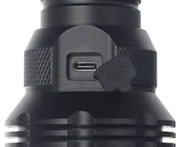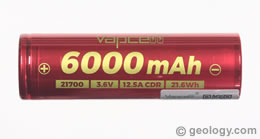The Excella 3-in-1 UV Flashlight

This 3-in-1 UV flashlight produces shortwave, midwave, and longwave ultraviolet light for examining fluorescent minerals and other items in a darkened classroom or office, or after dark in the field. At night, the light is bright enough to find fluorescent items on the ground while walking outdoors. It includes a USB-rechargeable 6000mAh lithium-ion battery. UV-blocking eye protection should be worn while using this lamp. One pair of adult-size UV-blocking safety glasses is included with the flashlight.
| UV Light Safety Exposure to shortwave, midwave, or longwave UV light can cause skin and eye injury. UV-blocking safety glasses or UV-blocking prescription glasses should be worn at all times while using the 3-in-1 UV flashlight. Do not look into a UV light. Take care not to shine the light towards the face of a person or pet, and do not shine it directly onto the skin. Clothing that covers the arms, legs, hands, and feet should be worn if this UV light will be used for extended periods of time. |
Uses
The 3-in-1 UV flashlight is a wonderful flashlight for those who want to hunt for fluorescent rocks and minerals outdoors after dark. If you are looking for a specific material, you can turn on one single wavelength; for example, using the longwave light to find Yooperlites. If you are looking for ANY rocks that are UV reactive, then you can turn on two or even all three wavelengths simultaneously. This eliminates the need to carry multiple lights and switch between them frequently.
We love using our 3-in-1 UV flashlight to illuminate fluorescent rocks, minerals, and gems. But the fun doesn't have to stop there! This light can also be used to examine seashells, postage stamps, currency, antique glassware, uranium glass, plants, and other items. Many toys and articles of clothing are UV reactive. Some people use this flashlight for detecting pet stains, curing UV resin, or even for finding scorpions! Take a look around your house, and you might be amazed by what lights up.
Shortwave Light (UVC / 255nm)
Pressing the leftmost button activates the shortwave UV light. This is the type of UV light that most fluorescent minerals respond to.Midwave Light (UVB / 310nm)
Pressing the button in the middle activates the midwave UV light. Some types of calcite respond well to midwave light.Longwave Light (UVA / 365nm)
Pressing the rightmost button activates the longwave UV light. The intensity of the longwave light can be adjusted if you press and hold this button.Please note: The "blacklights" sold in party and novelty stores use longwave UV light. Many common objects will fluoresce when illuminated with longwave UV light. However, only about 20% of fluorescent mineral specimens have an obvious response to longwave UV light. About 80% of specimens require shortwave UV illumination to display their fluorescent properties. A few minerals will respond to both shortwave and longwave UV illumination.
Darkness Required for Best Viewing
Most objects that respond to an ultraviolet light have a response that is too subtle to be seen under normal daylight or under the normal illumination of a classroom or office. Fluorescent objects are best observed by taking them into a dark room or closet and illuminating them with the UV light. The darker the surroundings, the better you will be able to observe a fluorescent response, especially if that response is not very strong.
Specifications
 Power: A USB-rechargeable 6000mAh 21700 lithium-ion battery is included. The battery should be inserted with the positive end facing toward the LEDs. The flashlight is capable of using the following sizes of lithium-ion batteries: 32650, 26650, 21700, and 18650. Adapter tubes are included to enable the use of the 26650, 21700, and 18650 battery sizes. Power: A USB-rechargeable 6000mAh 21700 lithium-ion battery is included. The battery should be inserted with the positive end facing toward the LEDs. The flashlight is capable of using the following sizes of lithium-ion batteries: 32650, 26650, 21700, and 18650. Adapter tubes are included to enable the use of the 26650, 21700, and 18650 battery sizes.IMPORTANT: The 3-in-1 UV Flashlight is compatible with Lithium-ION batteries in the sizes listed above. DO NOT use Lithium IRON Phosphate (LiFePO4) batteries, as they are the wrong chemistry. Using the wrong batteries can cause injury and ruin the flashlight.   Charging: A USB charging cable is included. To charge, connect the USB-C plug to the flashlight, and connect the USB-A plug to a standard USB port, power bank, or wall charger. USB-A ports are commonly found on computers, modern car consoles, and the wall chargers used for many Android cell phones. The buttons will blink while charging is in progress. When all 3 buttons turn green, charging is complete. Charging: A USB charging cable is included. To charge, connect the USB-C plug to the flashlight, and connect the USB-A plug to a standard USB port, power bank, or wall charger. USB-A ports are commonly found on computers, modern car consoles, and the wall chargers used for many Android cell phones. The buttons will blink while charging is in progress. When all 3 buttons turn green, charging is complete. Shortwave LED: PKB-S50-F36-H1, 100mW radiant output Shortwave LED: PKB-S50-F36-H1, 100mW radiant output Midwave LED: PKF-50-F35, 100mW radiant output Midwave LED: PKF-50-F35, 100mW radiant output Longwave LED: CUN6GB1A, up to 2000mW radiant output Longwave LED: CUN6GB1A, up to 2000mW radiant output Lens: Dichroic UV bandpass filter Lens: Dichroic UV bandpass filter Size: 5 11/16" long, 2 1/2" wide Size: 5 11/16" long, 2 1/2" wide Weight: approximately 16.2 ounces with included battery, 12.6 ounces without Weight: approximately 16.2 ounces with included battery, 12.6 ounces without Warranty: 1-year manufacturer warranty against defects. Warranty: 1-year manufacturer warranty against defects. What's included: Excella 3-in-1 UV flashlight, UV-blocking polycarbonate safety glasses, lens cleaning cloth, rechargeable 6000mAh 21700 lithium-ion battery, USB charging cable, and 3 battery adapter tubes. (In an effort to reduce electronic waste, a USB wall charger is NOT included.) What's included: Excella 3-in-1 UV flashlight, UV-blocking polycarbonate safety glasses, lens cleaning cloth, rechargeable 6000mAh 21700 lithium-ion battery, USB charging cable, and 3 battery adapter tubes. (In an effort to reduce electronic waste, a USB wall charger is NOT included.) |
Summary
Of all the UV lamps and lights we have tried, the Excella 3-in-1 UV flashlight is our favorite. We were intimidated by the price at first, but now that we have used the flashlight, we believe that the convenience and versatility it provides are well worth the investment. This is a quality piece of equipment that should last for many years. Supplies are limited, so get yours today!

Extra Rechargeable Battery
IMPORTANT: The 3-in-1 UV Flashlight is compatible with Lithium-ION batteries. DO NOT use Lithium IRON Phosphate (LiFePO4) batteries, as they are the wrong chemistry. Using the wrong batteries can cause injury and ruin the flashlight.
Learn More About Fluorescent Minerals
If you are interested in learning more about fluorescent minerals, Geology.com has an introductory article that is free for anyone to read. We sell fluorescent mineral collections that contain a number of minerals that respond to the lamp sold above. Finally, we offer two popular books by Stuart Schneider: Collecting Fluorescent Minerals and The World of Fluorescent Minerals.
Related Fluorescent Items
 Collecting Fluorescent Minerals |
 The World of Fluorescent Minerals |
 Fluorescent Mineral Collection |
